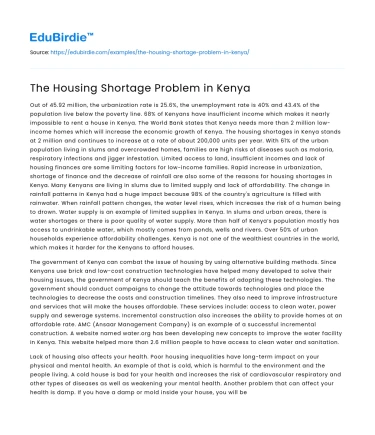Out of 45.92 million, the urbanization rate is 25.6%, the unemployment rate is 40% and 43.4% of the population live below the poverty line. 68% of Kenyans have insufficient income which makes it nearly impossible to rent a house in Kenya. The World Bank states that Kenya needs more than 2 million low-income homes which will increase the economic growth of Kenya. The housing shortages in Kenya stands at 2 million and continues to increase at a rate of about 200,000 units per year. With 61% of the urban population living in slums and overcrowded homes, families are high risks of diseases such as malaria, respiratory infections and jigger infestation. Limited access to land, insufficient incomes and lack of housing finances are some limiting factors for low-income families. Rapid increase in urbanization, shortage of finance and the decrease of rainfall are also some of the reasons for housing shortages in Kenya. Many Kenyans are living in slums due to limited supply and lack of affordability. The change in rainfall patterns in Kenya had a huge impact because 98% of the country's agriculture is filled with rainwater. When rainfall pattern changes, the water level rises, which increases the risk of a human being to drown. Water supply is an example of limited supplies in Kenya. In slums and urban areas, there is water shortages or there is poor quality of water supply. More than half of Kenya’s population mostly has access to undrinkable water, which mostly comes from ponds, wells and rivers. Over 50% of urban households experience affordability challenges. Kenya is not one of the wealthiest countries in the world, which makes it harder for the Kenyans to afford houses.
The government of Kenya can combat the issue of housing by using alternative building methods. Since Kenyans use brick and low-cost construction technologies have helped many developed to solve their housing issues, the government of Kenya should teach the benefits of adopting these technologies. The government should conduct campaigns to change the attitude towards technologies and place the technologies to decrease the costs and construction timelines. They also need to improve infrastructure and services that will make the houses affordable. These services include: access to clean water, power supply and sewerage systems. Incremental construction also increases the ability to provide homes at an affordable rate. AMC (Ansaar Management Company) is an example of a successful incremental construction. A website named water.org has been developing new concepts to improve the water facility in Kenya. This website helped more than 2.6 million people to have access to clean water and sanitation.
Save your time!
We can take care of your essay
- Proper editing and formatting
- Free revision, title page, and bibliography
- Flexible prices and money-back guarantee
Lack of housing also affects your health. Poor housing inequalities have long-term impact on your physical and mental health. An example of that is cold, which is harmful to the environment and the people living. A cold house is bad for your health and increases the risk of cardiovascular respiratory and other types of diseases as well as weakening your mental health. Another problem that can affect your health is damp. If you have a damp or mold inside your house, you will be more likely to have respiratory problems, allergies and asthma. Research found people with asthma that were twice as likely to live in homes with damps. There were nearly 1 million homes in the UK which contained damp problems in 2012. Damp problems are most likely found in private home and are least likely found in owner-occupied homes. Damp problems can also cause condensation, but it can also be caused by leaking pipes and wastes.
To prevent the cold weather, the government of Kenya can sell free thermostats, which could help the Kenyans a lot because when half of the population of Kenya sleeps with no shelter above their head, they have to experience the consequences of the weather. Thermostats can at least help them in Winter by providing some heat. The government can also tell all the Kenyans in the country to avoid condensation by keeping low background heat all day. Governments should provide Kenyans houses that are affordable so that the Kenyans at least have shelter above their heads. You can prevent molds by using a vacuum cleaner with high efficiency particulate air filter or use fans or open windows in the bathroom and kitchen when showering, cooking or using the dishwasher.
In conclusion, the strategies were successful and the Kenya government is starting to develop new houses. Kenya and the UN signed a contract stating that UN are delivering 100,000 affordable housing units. This tells us that Kenya is starting to overcome the issue, lack of housing and soon Kenya’s economic growth will increase.






 Stuck on your essay?
Stuck on your essay?

